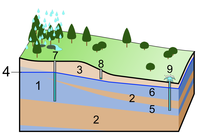
Photo from wikipedia
Assessment of groundwater quality and health risk was conducted in the Shenfu coal mine area in Ordos basin, northwestern China. Statistical analysis, Piper and Chadha diagrams were used to reveal… Click to show full abstract
Assessment of groundwater quality and health risk was conducted in the Shenfu coal mine area in Ordos basin, northwestern China. Statistical analysis, Piper and Chadha diagrams were used to reveal the hydrogeochemical characteristics of groundwater via physicochemical analysis of 44 collected samples. The suitability of groundwater was assessed for domestic and irrigation purposes, and the fuzzy comprehensive method was adopted to assess the overall groundwater quality for further discussion on groundwater management. The model recommended by the USEPA was selected to estimate the non-carcinogenic risks caused by NO3−, NO2−, NH4+, F−, Fe and Mn through oral ingestion and direct dermal contact. The results revealed that the predominant hydrochemical types of groundwater were SO4∙Cl–Ca∙Mg and HCO3–Ca∙Mg types and the major cations and anions followed the orders of Ca2+ > Na+ > Mg2+ >K+ and HCO3− > SO42− > Cl−, respectively. Groundwater is generally acceptable for irrigation. However, for domestic purposes, 47.73% of the collected samples are of excellent and good quality and are suitable for direct consumption. Both adults and children face non-carcinogenic risks because of exposure to contaminants such as nitrate, nitrite and fluoride. The risk to children is higher than that to adults, which is consistent with other studies. Nitrite contributes most to the risks, followed by nitrate and fluoride. Home-use water quality improvement devices and rainwater harvesting are suggested to enhance the groundwater quality protection and management in this area. The research also indicates that health risk assessment should always accompany general water quality assessment to ensure the reliability of the water quality assessment.
Journal Title: Environmental Earth Sciences
Year Published: 2019
Link to full text (if available)
Share on Social Media: Sign Up to like & get
recommendations!